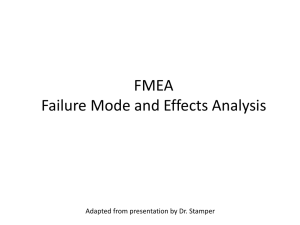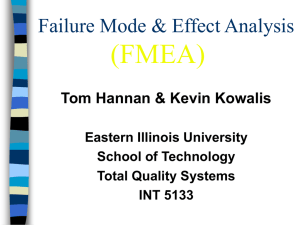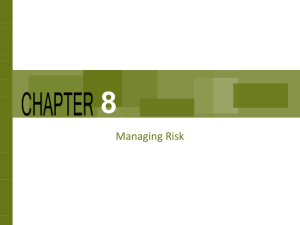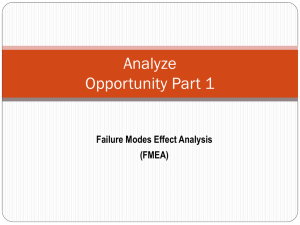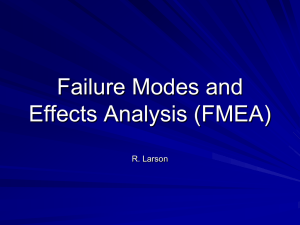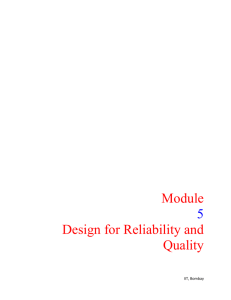FMEA.ppt - Rose
advertisement
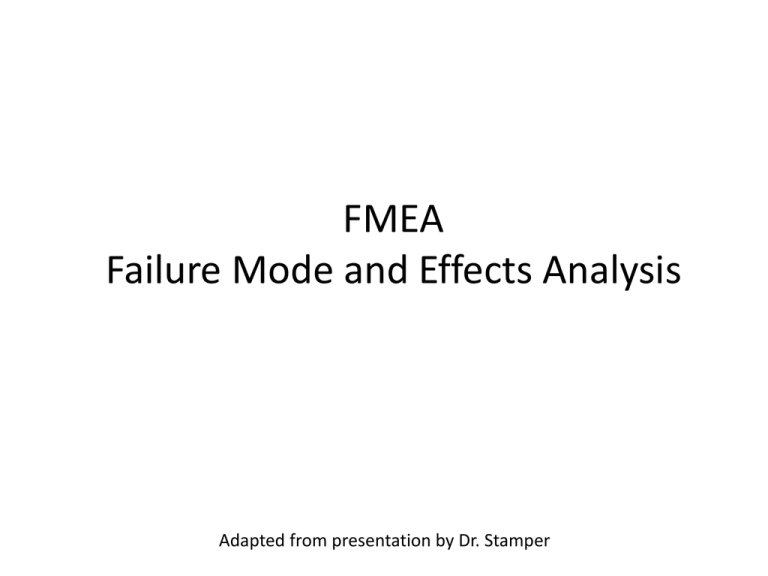
FMEA Failure Mode and Effects Analysis Adapted from presentation by Dr. Stamper Outline • Failure Mode and Effects Analysis – – – – What is it? Motivation FMEA Methods Example • FMEA in-class exercise What is an FMEA? Description: • A procedure that examines each item in a system, considers how that item can fail and then determines how that failure will affect (or cascade through) the system Acronyms • FMEA: Failure Modes and Effects Analysis • FMECA: Failure Modes and Effects and Criticality Analysis Motivation for Conducting a FMEA • Improves design by discovering unanticipated failures • Highlights the impact of the failures • Potentially helpful during legal actions • Provides a method to characterize product safety • Often required (e.g. FDA and DOD procurement) Method to Conduct an FMEA (taken from ASM Handbook Vol. 11) • Identify all components or systems at given level of the design hierarchy. • List the function of each identified component or system. • Identify failure modes for each component/system. Typically there will be several ways in which a component can fail. • Determine the effect (both locally and globally) on the system. Method to Conduct an FMEA (taken from ASM Handbook Vol. 11) • Classify the failure by its effects on the system operation. • Determine the failure’s probability of occurrence. • Identify how the failure mode can be detected (may point out what needs to be inspected on a regular basis). • Identify any compensating provisions or design changes to mitigate the failure effects. Other Variations of the Method • Mil-STD-1629A, Fig 101.3 http://www.fmea-fmeca.com/milstd1629.pdf • SAE J1739 http://www.fmea-fmeca.com/fmeaexamples.html DESIGN FMEA (DFMEA) • The Design FMEA is used to analyze products before they are released to production. • It focuses on potential failure modes of products caused by design deficiencies. • Design FMEAs are normally done at three levels – system, subsystem, and component levels. • This type of FMEA is used to analyze hardware, functions or a combination. PROCESS FMEA (PFMEA) • The Process FMEA is normally used to analyze manufacturing and assembly processes at the system, subsystem or component levels. • This type of FMEA focuses on potential failure modes of the process that are caused by manufacturing or assembly process deficiencies. FMEA Template for AIAG and Six Sigma Prepared By: Date: 00/00/00 Item Function Potential Failure Mode Potential Effects or Failure S v r t y Potential Causes of Failure MEADinfo Product FMEA No/Rev: 0000/01 Process/Component: O D Current c t Controls for r c Prevention/ n t Detection c n Action Results R P N Responsibility S Recommended and Target v Action Completion Action Taken r Date t y O c r n c 0 0 0 0 0 0 0 0 0 0 0 0 0 0 0 0 0 0 0 0 http://www.meadinfo.org/2009/11/download-fmea-template-aiag-six-sigma.html D t c t n R P N 0 0 0 0 0 0 0 0 0 0 0 0 0 0 0 0 0 0 0 0 What to Do • Function comes from Functional Analysis, Functional Decomposition • Potential Failure Mode comes from things that have gone wrong in the past, concerns of designers, and brainstorming. Possible considerations are partial function, intermittent function, excess function. • Potential Effects are consequences to the design, the user, and the environment. Safety and regulation noncompliance are critical issues. IN-CLASS PROBLEM 1 Most cars have a fuel filter between the fuel tank and the engine. Consider the consequences of a) Anti-function (opposite of filtering) b) Partial function c) Intermittent function d) Excess function What to Do • Potential Causes of failure should be engineering related such as incorrect material, corrosion, wear and human related such as inexperience, misuse, etc. • Current Design Controls are things like inspections, testing, poke yoke, and other design checks that are intended to prevent the problem. What to Do • Assign values to Severity, Occurrence, and Detection using the tables on the next three pages. • Determine the Risk Priority Number (Severity* Occurrence * Detection) • Develop an action plan • Implement an action plan http://www.meadinfo.org/2009/11/download-fmea-template-aiag-six-sigma.html Severity Guidelines Effect Rank Criteria None 1 No effect Very Slight 2 Negligible effect on Performance. Some users may notice. Slight 3 Slight effect on performance. Non vital faults will be noticed by many users Minor 4 Minor effect on performance. User is slightly dissatisfied. Moderate 5 Reduced performance with gradual performance degradation. User dissatisfied. Severe 6 Degraded performance, but safe and usable. User dissatisfied. High Severity 7 Very poor performance. Very dissatisfied user. Very High Severity 8 Inoperable but safe. Extreme Severity 9 Probable failure with hazardous effects. Compliance with regulation is unlikely. Maximum Severity 10 Unpredictable failure with hazardous effects almost certain. Non-compliant with regulations. Occurrence Ranking (one interpretation) Occurrence Rank Criteria Extremely Unlikely 1 Less than 0.01 per thousand Remote Likelihood 2 0.1 per thousand rate of occurrence Very Low Likelihood 3 0.5 per thousand rate of occurrence Low Likelihood 4 1 per thousand rate of occurrence Moderately Low Likelihood 5 2 per thousand rate of occurrence Medium Likelihood 6 5 per thousand rate of occurrence Moderately High Likelihood 7 10 per thousand rate of occurrence Very High Severity 8 20 per thousand rate of occurrence Extreme Severity 9 50 per thousand rate of occurrence Maximum Severity 10 100 per thousand rate of occurrence Occurrence Ranking (another Interpretation) http://rmcpharmanews.blogspot.com/2010/06/informing-fmea.html Detection Ranking Detection Rank Criteria Extremely Likely 1 Can be corrected prior to prototype/ Controls will almost certainly detect Very High Likelihood 2 Can be corrected prior to design release/Very High probability of detection High Likelihood 3 Likely to be corrected/High probability of detection Moderately High Likelihood 4 Design controls are moderately effective Medium Likelihood 5 Design controls have an even chance of working Moderately Low Likelihood 6 Design controls may miss the problem Low Likelihood 7 Design controls are likely to miss the problem Very Low Likelihood 8 Design controls have a poor chance of detection Remote Likelihood 9 Unproven, unreliable design/poor chance for detection Extremely Unlikely 10 No design technique available/Controls will not detect IN-CLASS PROBLEM 2 Suppose you are designing an accelerator pedal assembly for an automobile. After the publicity of accelerator sticking issues and the multiple recalls, you are concerned about the function “Returns to original position after release.” Estimate the numbers for Severity, Occurrence, and Detection. Partial Example Partial Example (Cont.) IN-CLASS PROBLEM 3 We wish to generate an FMEA for an aerosol can (assume spray paint) a) Discuss the functions and list the three most significant b) For the function selected by the instructor, name PotentialFailure Modes c) For each Potential Failure Mode, name Potential Effects d) For each Potential Failure Mode, name Potential Causes e) For each Potential Failure Mode, assign Severity, Occurrence, and Detection values To Learn More • A collection of information including links to examples, guides, standards, etc. http://www.fmeainfocentre.com/index.htm • A training company with good overview material http://www.qualitytrainingportal.com/resources/fmea/index.htm • Another company http://www.fmea-fmeca.com/index.html

